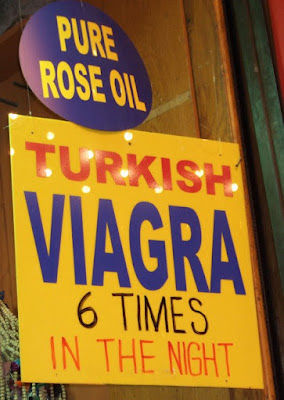 ...click photos to enlarge...After a somewhat sleep-jangled start,
...click photos to enlarge...After a somewhat sleep-jangled start, we went out to breakfast at a restaurant four stories up, on a rooftop, with a view along both shores of the Bosphorus Strait. The food was good, and I especially liked the fresh French bread and fresh-squeezed sour cherry juice. Then, we went to visit the Spice Bazaar, the Grand Bazaar, and take a tourist boat, along with hundreds of Turks, around the Bosphorus Strait.
The spice bazaar, while still functioning as a local fulcrum for purchasing bulk goods, also clearly now caters to tourists, selling many goods no local could ever want, or need. The spices looked great!
On the whole, the merchants were no more aggressive than you see in any other market in Mexico, or even Seattle's public market. There were hundreds of spice merchants, but also many people selling soccer jerseys, chess sets, hookahs, fezes, etc.
 The Spice Bazaar
The Spice Bazaar Turkish Viagra for sale
Turkish Viagra for sale Perfectly groomed mountains of spicesAfter our walk through the spice bazaar
Perfectly groomed mountains of spicesAfter our walk through the spice bazaar, we decided to take one of the many boat tours around the harbor and got on a boat the Turks were taking, avoiding the more expensive Euro-American tour. Shortly after boarding, Keelin read in her tour book that the boat ride was 8 hours long, and would involve a two hour captive stop at a restaurant! This boat did not even have a bathroom! After passing the bridge, and slowly turning around, we realized this would actually be a much shorter trip.
I could go on and on about this strait and its history of the strait, but if you're really interested, check out this footnote [1], a/k/a satellite data cluster.
 Keelin on the tour boat
Keelin on the tour boat A view from the boat
A view from the boatA pasha's mansion on the Bosphorus
 Twierdza Rumelli
Twierdza RumelliThe Bosphorus bridge between Asia and Europe
 The strait in a satellite view
The strait in a satellite view An old Pasha's mansion on the Strait
An old Pasha's mansion on the Strait
The strategic significance of the strait was one of the factors in the decision of the Roman Emperor Constantine the Great to found there in 330 AD his new capital, Constantinople, which came to be known as the capital of the Eastern Roman Empire. On May 29, 1453 it was conquered by the emerging Ottoman Empire. In fact, as the Ottoman Turks closed in on Constantinople, they constructed a fortification on each side of the strait, Anadoluhisarı (1393) and Rumelihisarı (1451). They later renamed the city Istanbul.
The strategic importance of the Bosporus remains high, and control over it has been an objective of a number of hostilities in modern history, notably the Russo-Turkish War, 1877-1878, as well as of the attack of the Allied Powers on the Dardanelles in 1915 in the course of the First World War. Several international treaties have governed vessels using the waters, including the Montreux Convention Regarding the Regime of the Turkish Straits, signed in 1936. In the conferences during World War II, Soviet leader Joseph Stalin openly requested the concession of Soviet military bases on the Turkish Straits, even though Turkey was not involved in the war. This incident, coupled with Stalin's demands for the restitution of the Turkish provinces of Kars, Artvin and Ardahan to the Soviet Union (which were lost by Turkey with the Russo-Turkish War (1877-1878) but were regained with the Treaty of Kars in 1921) was one of the main reasons why Turkey decided to give up its principle of neutrality in foreign affairs and join NATO in 1952. In more recent years, the Turkish Straits have become particularly important for the oil industry. Russian oil, from ports such as Novorossyisk, is exported by tankers to western Europe and the U.S. via the Bosphorus and the Dardanelles straits.
---o0o---

















